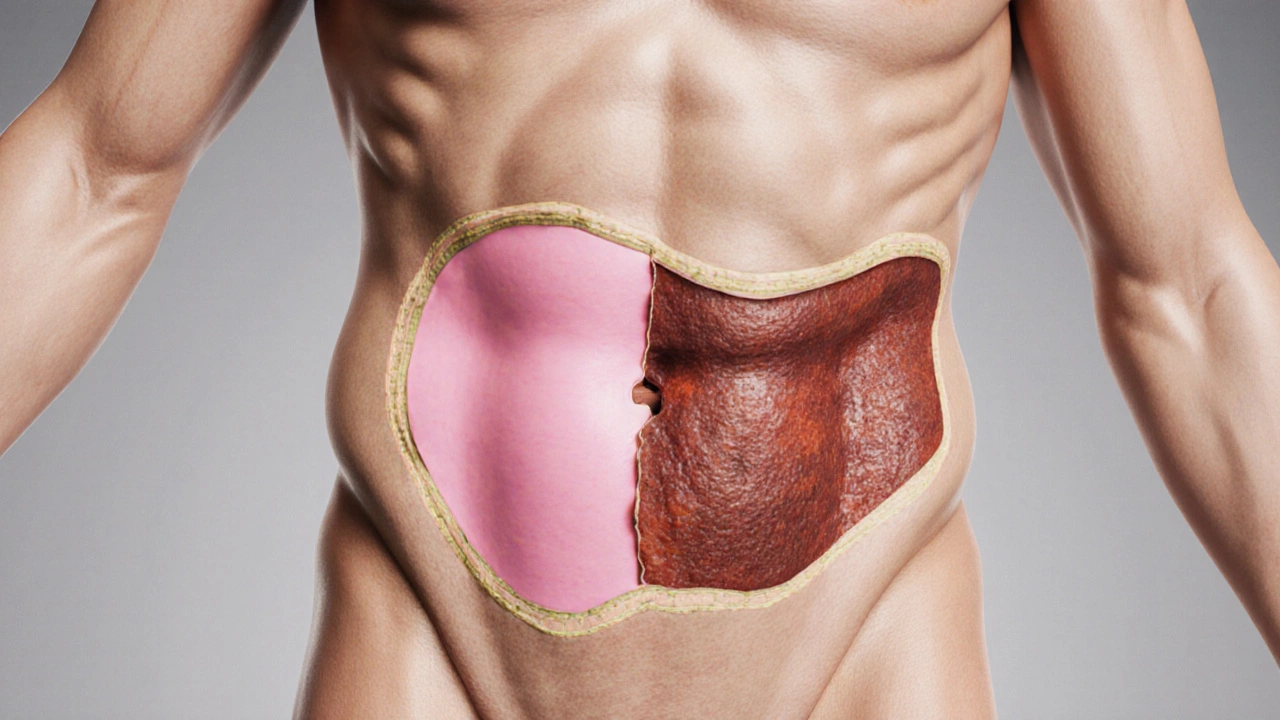How to Lose Belly Fat in 2 Weeks - Fast, Safe Plan
 Oct, 10 2025
Oct, 10 2025
Belly Fat Loss Calculator
Your 2-Week Belly Fat Loss Estimate
Important Notes
Results are estimates. Actual fat loss depends on factors like body composition, adherence, and individual metabolism. Consult a healthcare provider before starting any diet or exercise program.
Pro Tip:
Combine your calculated calorie deficit with 3 HIIT sessions and 2 strength-training days weekly for optimal belly fat reduction.
Staring at that stubborn belly and wondering if you can see results in just a fortnight? It’s a realistic goal if you combine the right calorie strategy, targeted workouts, and lifestyle tweaks. Below is a step‑by‑step roadmap that lets you lose belly fat safely without resorting to gimmicks.
Quick Takeaways
- Create a daily calorie deficit of 500-750kcal.
- Do 3HIIT sessions and 2 strength‑training days each week.
- Prioritise protein(1.6-2.2g/kg body weight) and keep carbs moderate.
- Sleep 7-9hours nightly and manage stress to protect metabolism.
- Follow the sample 2‑week plan for clear daily actions.
What is Belly Fat?
Belly fat refers to both subcutaneous fat under the skin and visceral fat surrounding internal organs. Visceral fat is metabolically active and linked to higher health risks, while subcutaneous fat is the softer layer you can pinch. Understanding the type you’re targeting helps shape diet and exercise choices.
Why a Calorie Deficit Works (Calorie Deficit)
A calorie deficit means you consume fewer kilocalories than your body expends. Research shows a steady 500kcal daily deficit yields about 0.5kg (1lb) of weight loss per week, which translates to roughly 1-2kg of belly fat over two weeks when combined with targeted workouts.
Calculate your maintenance calories using a reliable online calculator (multiply body weight by 33-35 for men, 30-32 for women). Subtract 500-750kcal to set your daily target.
Boost Fat Burn with HIIT (High‑Intensity Interval Training)
HIIT alternates short bursts of maximal effort with brief recovery periods, keeping heart rate elevated and increasing post‑exercise oxygen consumption (EPOC). Studies from 2023 show a 20‑minute HIIT workout can burn 2-3times more calories post‑session than steady‑state cardio.
Sample HIIT circuit (30seconds work, 30seconds rest, repeat 4times):
- Burpees
- Jump squats
- Mountain climbers
- High knees

Build Muscle with Strength Training
Muscle tissue burns more calories at rest than fat. Incorporating compound lifts (squats, deadlifts, push‑ups) two times a week preserves lean mass while you’re in a deficit. Aim for 3-4 sets of 8-12 reps at a weight that challenges the last rep.
Eat the Right Way - Macronutrients and Meal Timing
Protein is king. Consuming 1.6-2.2g per kilogram of body weight each day supports muscle repair and curbs hunger. Distribute protein across 3-4 meals to maximise muscle protein synthesis.
Carbohydrates should come mainly from vegetables, whole grains, and fruit. Keep simple sugars under 30g per day to prevent insulin spikes that favour fat storage.
Fats - especially omega‑3s from fish, nuts, and seeds - aid hormone balance. Aim for 0.8-1g per kilogram of body weight.
Lifestyle Levers: Sleep, Stress, and Metabolism
Sleep deprivation raises ghrelin (hunger hormone) and lowers leptin (satiety hormone), making calorie control harder. Prioritise 7-9hours of uninterrupted sleep; a dark room and consistent bedtime help.
Chronic stress releases cortisol, which encourages visceral fat accumulation. Incorporate 10‑minute mindfulness sessions, breathing exercises, or short walks to keep cortisol in check.
Metabolism naturally slows during a deficit, but the combination of HIIT, strength work, and adequate protein mitigates this drop.
Comparison of Popular 2‑Week Diet Strategies
| Approach | Calorie Target | Protein (g/kg) | Typical Carb % | Ease of Adherence |
|---|---|---|---|---|
| Standard Deficit | Maintenance-500kcal | 1.8-2.2 | 40‑45% | High |
| Low‑Carb | Maintenance-600kcal | 1.8-2.0 | 10‑20% | Medium |
| Intermittent Fasting (16/8) | Maintenance-500kcal (eaten within 8h) | 1.6-2.0 | 30‑35% | Variable |

Sample 2‑Week Action Plan
Follow this schedule to keep calories, workouts, and recovery in sync.
| Day | Calories (kcal) | Workout | Key Nutrition Focus |
|---|---|---|---|
| Mon | Maintenance‑500 | HIIT (20min) | Protein 30g each meal |
| Tue | Maintenance‑500 | Strength (Full‑body) | Include leafy veg, omega‑3 fish |
| Wed | Maintenance‑500 | Active recovery (walk 30min) | High‑fiber carbs, hydrate |
| Thu | Maintenance‑500 | HIIT (20min) | Limit added sugars |
| Fri | Maintenance‑500 | Strength (Upper focus) | Spread protein evenly |
| Sat | Maintenance‑500 | HIIT (20min) + core circuit | Focus on veggies, moderate carbs |
| Sun | Maintenance‑500 (or 750kcal if feeling fatigued) | Rest + stretching | Prioritise sleep, low‑stress meals |
Common Pitfalls & How to Dodge Them
- Relying on scale alone: Water fluctuations can mask fat loss. Use waist measurements or progress photos.
- Skipping meals: Leads to bingeing later. Eat regular, balanced meals to keep hunger in check.
- Neglecting strength work: You’ll lose muscle, lowering metabolic rate. Keep at least two resistance sessions.
- Over‑training: Too many HIIT sessions without recovery spikes cortisol. Stick to 3‑4 intense days max.
- Alcohol excess: Adds empty calories and impairs fat oxidation. Limit to one drink on weekends.
Tracking Progress Effectively
Measure waist circumference at the same spot (mid‑point between rib cage and hip) every morning. A drop of 1cm per week signals genuine fat loss. Pair this with a simple log of calories, workout duration, and sleep hours.
Frequently Asked Questions
Can I really see belly fat loss in just two weeks?
Yes, if you maintain a consistent calorie deficit of 500‑750kcal, combine HIIT with strength training, and optimize sleep and stress, most people lose 0.5‑1kg of fat, which often translates to a slimmer waist.
Do I need to count every calorie?
Tracking helps you stay on target, especially the first week. After establishing your baseline, you can shift to estimating portions and using a food diary for a few days each week.
Is cardio enough without strength training?
Cardio burns calories, but strength training preserves muscle, which keeps your resting metabolic rate higher. Skipping it can lead to a bigger calorie drop needed for the same fat loss.
How much water should I drink?
Aim for at least 2.5L per day, more if you sweat heavily during HIIT. Proper hydration supports metabolism and reduces water retention.
What if I hit a plateau after the first week?
Plateaus are normal. Slightly adjust calories (±100kcal), add a new HIIT interval variation, or insert a dedicated mobility day to keep the body guessing.